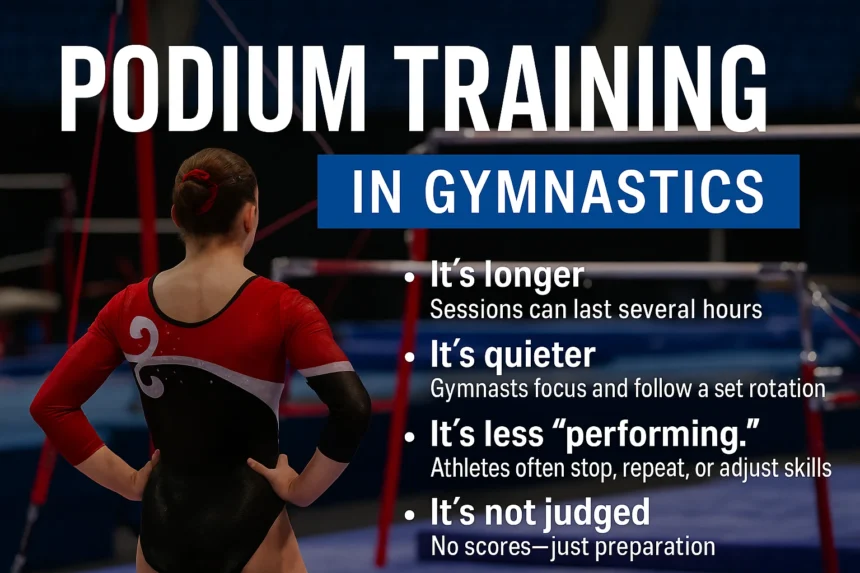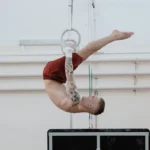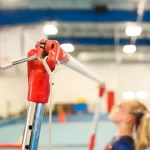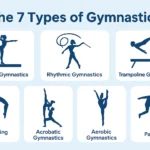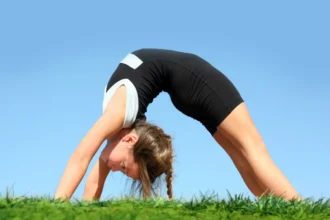If your child is heading to a big gymnastics meet, you may hear their coach mention something called podium training. It may sound unfamiliar, but it’s a completely normal and very important.
What Exactly Is Podium Training?
Podium training is the official practice session held one day before a major gymnastics competition. It allows gymnasts to warm up, try their routines, and test the equipment on the actual competition floor.
It’s called podium training because, at big meets like the Olympics, Nationals, or large invitationals, the equipment sits on a raised platform known as a podium. This raised stage gives the equipment a slightly different feel, especially the floor, beam, and bars, so gymnasts need time to adjust before they compete.
For many athletes, podium training helps them feel comfortable with the arena, the lighting, and the equipment so they can perform confidently on meet day.
In simple terms:
Podium training is a rehearsal for competition day.
The Podium Training Schedule: How It Works
The schedule for podium training varies by meet level, but most follow a similar structure. Here’s what parents can expect.
1. Arrival, Check-In, and Team Meeting
Gymnasts arrive well before their scheduled training time. Depending on the size of the competition, this may include:
- credential checks
- athlete badges
- bag inspection
- security screening
- checking into a designated athlete area
Once inside, gymnasts meet with their coach for a short briefing. They review:
- the rotation order
- warm-up plan
- individual focuses for each event
- any reminders about equipment differences or safety
This sets the tone for a focused training session.
2. General Warm-Up
Before touching any apparatus, all gymnasts complete a full-body warm-up. This typically includes:
- light jogging or dynamic movement
- stretching for shoulders, hips, hamstrings, and ankles
- core activation
- basic dance fundamentals (for beam and floor)
- easy tumbling drills
- balance, shaping, and handstand work
This portion lasts about 10–20 minutes depending on the meet. It helps athletes loosen up and get mentally settled before entering the arena.
3. March-In or Arena Transition
After warm-up, the team transitions into the main competition floor. At elite or national meets, this often feels like a mini “march-in,” where athletes:
- line up
- walk together into the arena
- move to their assigned starting event
This helps them get a preview of what the meet-day introduction will feel like.
4. Event Rotations (The Core of Podium Training)
Podium training follows the same event order athletes will use during the actual competition.
For Women’s Artistic Gymnastics (WAG), the usual order is:
Vault → Bars → Beam → Floor
For Men’s Artistic Gymnastics (MAG), the order is:
Floor → Pommel Horse → Rings → Vault → Parallel Bars → High Bar
Each rotation has a set time limit, usually:
- 10–15 minutes per gymnast in elite-level meets
- 20–30 minutes per event in group-based warm-ups
- Longer time blocks for teams doing full routines
During each rotation, gymnasts:
- test the equipment
- perform skills and connections
- practice dismounts
- adjust their timing
- get coaching feedback
- make mental notes for the next day
This is the most important part of podium training because it’s where gymnasts learn how the apparatus differs from their home gym.
5. Equipment Testing and Adjustments
While rotating through events, staff members stay nearby to make equipment changes as needed. Common adjustments include:
- tightening or loosening bar tension
- adjusting bar spacing (for uneven bars)
- raising or lowering the vault table
- moving mats to preferred angles or distances
- wiping or brushing the beam
- checking floor corner spacing for tumbling passes
These fine-tuning adjustments help the gymnast feel more secure and comfortable before competition.
6. “Full-Out” Optional Routine Practice (Varies by Coach)
Not every gymnast will perform a full routine during podium training. Coaches choose an approach based on the athlete’s readiness and the meet’s intensity.
Common strategies:
- Full routine on one event, partial routines on others
- Dismount-only repetitions (e.g., stick training)
- Skill-testing only, skipping connections
- One full tumbling pass only on floor
- Dance-through on beam and floor to check spacing
The purpose is not to score or impress, it’s to collect information and feel prepared.
7. Arena Walk-Through and Mental Mapping
Before leaving the arena, coaches often lead gymnasts through a short mental-prep session. This may include:
- walking the floor to check corner distances
- marking turns or landing spots
- visualizing the order of skills
- rehearsing salutes
- noting where judges will sit
- practicing choreography spacing
This mental mapping helps ensure nothing feels “new” on meet day.
Podium Training vs. Regular Practice: Key Differences
Podium training looks like regular practice, but it serves a completely different purpose. It helps gymnasts adjust to the real competition setup. Unlike daily gym practice, which builds strength and skills over time, podium training is a rehearsal that helps gymnasts feel comfortable before competing.
As one parent explained, “The equipment is raised and can have more bounce… podium training lets everyone adjust.” (Source: Reddit)
| Topic | Podium Training | Regular Practice |
|---|---|---|
| Goal | Adjust to competition equipment and arena. | Build skills, strength, and technique. |
| Environment | Big arena with bright lights and podium setup. | Familiar, calm home gym. |
| Equipment | Actual competition gear (often feels different). | Same equipment gymnasts use every day. |
| Focus | Test equipment, spacing, and routines. | Drills, conditioning, corrections. |
| Pressure | Moderate—rehearsal mindset. | Low—learning mindset. |
What Parents Should Expect
Podium training may feel different from regular gymnastics practice:
It’s longer.
Podium training sessions usually last several hours, with more waiting time between turns than a typical gym practice.
It’s quieter.
The arena atmosphere is calm and focused. Gymnasts follow a set rotation from event to event and listen closely to their coaches.
It’s less about performing.
You may see your gymnast stop mid-routine, repeat a skill, or walk through choreography. This isn’t a problem as podium training is all about adjusting to the equipment and learning how the arena feels.
It’s not judged.
There are no scores or rankings during podium training. The entire session is for preparation, not performance.
If parents are allowed to watch, it’s a great chance to see the athletes in a more relaxed, behind-the-scenes setting.
